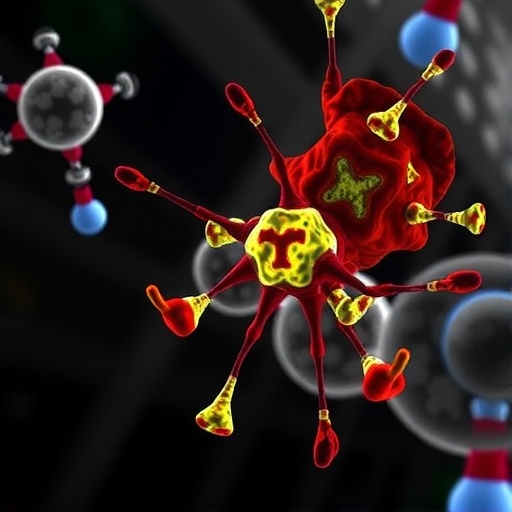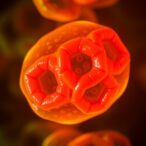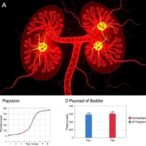
In recent years, the landscape of multiple myeloma treatment has witnessed transformative advances, notably with the emergence of chimeric antigen receptor T-cell (CAR-T) therapies targeting the B-cell maturation antigen (BCMA). A groundbreaking study published in Nature Communications by Atanackovic et al. delves deeply into the intricate immune correlates associated with two FDA-approved anti-BCMA CAR-T products: idecabtagene vicleucel (ide-cel) and ciltacabtagene autoleucel (cilta-cel). Drawing from a real-world patient cohort, this investigation sheds light on the nuanced immunological factors that underlie the efficacy, durability, and variability of responses in multiple myeloma, offering crucial insights that may redefine therapeutic strategies.
Multiple myeloma, a hematological malignancy characterized by proliferation of malignant plasma cells, has long posed clinical challenges due to its intricate pathophysiology and frequent relapse after conventional therapies. CAR-T cell therapies, by genetically engineering patients’ own T cells to express receptors specific to BCMA—a surface protein highly expressed on malignant plasma cells—have revolutionized treatment paradigms. Ide-cel and cilta-cel, the vanguards of this wave, have demonstrated remarkable response rates in clinical trials; however, their real-world performance and mechanistic immunological correlates had been less characterized until now.
The study by Atanackovic and colleagues meticulously profiled immune parameters in patients receiving either ide-cel or cilta-cel, aiming to decode the cellular and molecular determinants of response and resistance. By analyzing extensive immunophenotyping, cytokine profiles, and cellular functional assays, the researchers reveal how differential T-cell subsets, activation states, and the tumor microenvironment collaborate to influence therapeutic outcomes. Their findings uncover heterogeneity not just at the level of CAR-T cell expansion and persistence but also in the interplay between effector T-cell function and immune suppression within the bone marrow niche.
.adsslot_2r8yOqdbR5{width:728px !important;height:90px !important;}
@media(max-width:1199px){ .adsslot_2r8yOqdbR5{width:468px !important;height:60px !important;}
}
@media(max-width:767px){ .adsslot_2r8yOqdbR5{width:320px !important;height:50px !important;}
}
ADVERTISEMENT
A central revelation is the distinct immunological signature associated with each CAR-T product. Ide-cel treatment correlated with a rapid but transient expansion of CAR-T cells, accompanied by a cytokine milieu that favored effector differentiation but also induced early exhaustion markers. Conversely, cilta-cel engendered a more sustained CAR-T presence, characterized by memory-like T-cell subsets exhibiting superior proliferative potential and longevity. This dichotomy offers a mechanistic explanation for the more durable remissions observed in cilta-cel recipients, emphasizing the importance of T-cell phenotypic quality over mere quantitative expansion.
Furthermore, the study underscores the role of tumor antigen burden and its modulation of CAR-T efficacy. Patients harboring high BCMA expression on malignant cells exhibited enhanced initial CAR-T activation but also greater susceptibility to antigen-induced exhaustion, suggesting a paradoxical effect where robust target engagement could precipitate functional attrition of therapeutic cells. This insight stresses the need to balance antigen targeting intensity with strategies that preserve T-cell vitality, potentially through combinatorial modalities or engineered CAR constructs with built-in resistance to exhaustion.
In addition to cellular correlates, soluble factors within the tumor microenvironment emerged as critical mediators of CAR-T cell functionality. Elevated levels of immunosuppressive cytokines such as transforming growth factor-beta (TGF-β) and interleukin-10 (IL-10) were linked to diminished CAR-T proliferation and cytotoxicity. These suppressive milieus may blunt the anti-tumor activity, pointing to therapeutic opportunities for adjunctive agents that modulate the microenvironment to bolster CAR-T potency. Moreover, differential expression of immune checkpoints such as PD-1 and LAG-3 on CAR-T cells was mapped, revealing nuanced landscapes of exhaustion and activation that could be therapeutically targeted to reinvigorate these effector cells.
Notably, the researchers also explored the contribution of non-CAR endogenous T-cell populations to therapy outcomes. The interplay between CAR-T cells and the host’s immune repertoire influences both direct tumor cytolysis and the establishment of long-term immunological memory. The data indicate that preservation of a diverse and functional endogenous T-cell pool correlates with sustained remission, suggesting that immune system resilience beyond CAR-T cells themselves is a vital component of therapeutic success.
The meticulous profiling extended to assessing how prior treatment regimens and patient-specific factors modulate immune responses post-CAR-T infusion. Pre-existing immune exhaustion, accumulated through previous lines of chemotherapy or immunomodulatory drugs, potentially compromises CAR-T cell expansion and effector function. These findings advocate for personalized therapeutic timelines and immune status evaluations prior to CAR-T therapy initiation to maximize efficacy.
This comprehensive immunological framework also informs emerging strategies to overcome resistance mechanisms. Some patients demonstrated relapse linked to antigen escape via BCMA downregulation or mutation, highlighting the dynamic evolutionary pressures CAR-T cells impose on the tumor. The study calls for innovative CAR designs incorporating dual antigen targeting or synthetic biology circuits to sustain anti-myeloma activity despite tumor adaptation.
Beyond mechanistic insights, the study’s real-world cohort analysis holds profound clinical implications. Unlike controlled trial cohorts, real-world patients present with heterogeneous disease characteristics, comorbidities, and treatment backgrounds, offering a more pragmatic assessment of CAR-T efficacy and safety. The data support that clinical outcomes parallel immunologic findings and that robust immune correlates can serve as predictive biomarkers for patient stratification and early response monitoring.
Importantly, the safety profiles of ide-cel and cilta-cel in this cohort reiterated known toxicities such as cytokine release syndrome (CRS) and neurotoxicity while correlating immune markers of systemic inflammation to adverse event severity. Understanding the immunological underpinnings of these toxicities may enable preemptive management and refine dosing strategies to enhance patient safety without sacrificing efficacy.
Escalating this work, future investigations integrating single-cell multi-omics and longitudinal immune monitoring promise to unravel even deeper layers of complexity within the CAR-T and tumor microenvironment interface. Harnessing such data can accelerate the development of next-generation CAR-T therapies, potentially characterized by enhanced persistence, reduced toxicity, and the ability to overcome tumor immune evasion mechanisms.
In sum, Atanackovic et al.’s seminal study represents a landmark in the ongoing evolution of multiple myeloma immunotherapy. By charting the intricate immune correlates of ide-cel and cilta-cel CAR-T treatments in a real-world setting, the research delineates crucial pathways toward optimizing therapeutic durability and precision. As CAR-T therapies expand their reach and sophistication, such foundational immunological knowledge will be indispensable in translating promise into sustained clinical triumphs for patients worldwide.
Subject of Research:
The study investigates the immune correlates and mechanisms underlying the efficacy and resistance of anti-BCMA CAR-T therapies—specifically idecabtagene vicleucel and ciltacabtagene autoleucel—in treating multiple myeloma patients.
Article Title:
Immune correlates of anti-BCMA CAR-T products idecabtagene vicleucel and ciltacabtagene autoleucel in a real-world cohort of patients with multiple myeloma.
Article References:
Atanackovic, D., Luetkens, T., Schneider, D. et al. Immune correlates of anti-BCMA CAR-T products idecabtagene vicleucel and ciltacabtagene autoleucel in a real-world cohort of patients with multiple myeloma. Nat Commun 16, 6154 (2025). https://doi.org/10.1038/s41467-025-60980-2
Image Credits: AI Generated
Tags: anti-BCMA CAR-T therapyB-cell maturation antigen targeting in myelchimeric antigen receptor T-cell therapyciltacabtagene autoleucel response variabilityFDA-approved myeloma treatmentsidecabtagene vicleucel efficacyimmune markers in multiple myelomaimmunological factors in cancer treatmentmechanistic correlates of CAR-T therapyplasma cell malignancy therapiesreal-world patient cohort myelomatherapeutic strategies for multiple myeloma



